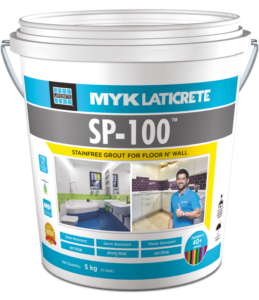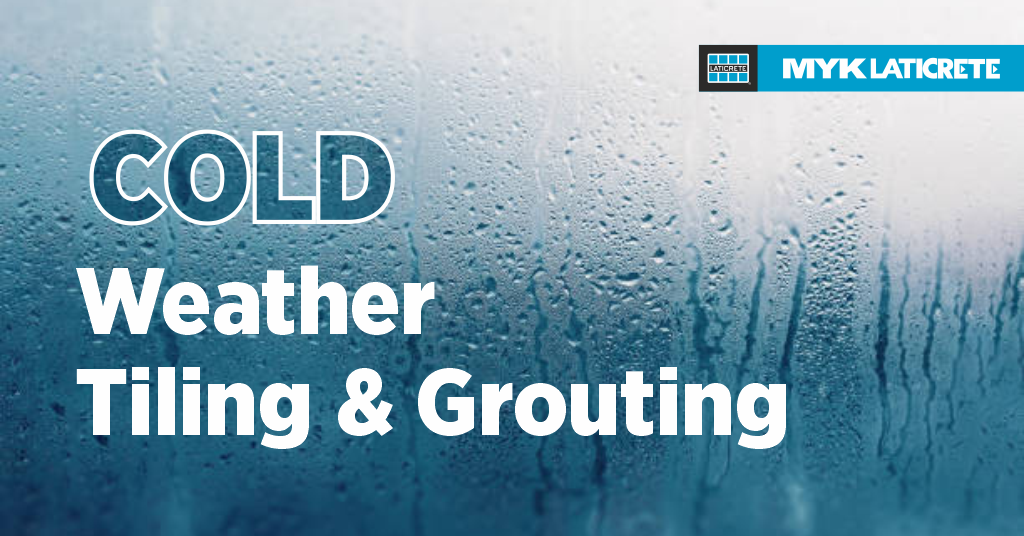Q. What is the effect of cold weather on tiling and grouting operations?
A. Conventional Portland cement tile setting beds, thin-set mortars, grouts and cement plasters are often permanently damaged when subject to below freezing temperatures immediately after installation. The water content of a mortar turning into ice often results in Portland cement gel structure rupturing with significant loss in strength, flexibility and durability. Subsequent repairs to the damaged work and resulting site delays are extremely costly.
Q. How does low or high temperature effect the tile setting and grouting materials?
A. There is a simple rule to follow when the temperature is low during installation: The 8 ºC Rule (18º F) – for every 8ºC below 21ºC (18ºF below 70ºF), Portland cement and epoxy based materials take twice as long to cure.
For example if it takes 24 hours for an adhesive to set @21º C, then it takes 48 hours for the same adhesive to set @ 13ºC. In those climatic conditions, selection of appropriate screeds, mortars and adhesives is very critical to avoid weather related failures. MYK LATICRETE offers several specialized thick bed and thin bed tile and stone installation systems that suit all weather conditions.
Q. What is the solution from MYK LATICRETE to make sure the tile laying and grouting work is not damaged during cold weather?
A. There are two solutions offered by MYK LATICRETE for ensuring best performance of tile and grout installations.
Liquid Latex Fortified Mortars, Screeds and Plasters
The use of 4237 Latex Additive in thin-sets and 3642 Mortar Admix and 73 Latex Admix in thinsets, grouts, plasters, stuccos and other portland cement mortars allows work to continue in cold weather without costly delays or damage. Frost, ice and thermal shock do not damage LATICRETE® Latex Fortified Mortars after placement.
Installations can be made at temperatures as low as 2°C (35°F).
Rapid Setting Latex Fortified Mortars
The use of a premium rapid-setting thin-set mortar will also help to accelerate the setting time in cooler temperatures. FSA 336 is ideal for this application. The use of 73 Rapid Latex Admix mixed with unmodified LATICRETE® Thin-Set Mortars, Medium Bed Mortars and LATICRETE® 111 Crete Filler Powder, bagged mortars allow work to take place and can quickly return newly tiled areas back to service in cooler temperatures.
Q. What other precautions need to be taken to ensure MYK LATICRETE products performance during cold weather conditions?
A. Shipping and Storage
For best results, always ship and store installation materials at temperatures above freezing so they will be ready to use when needed.
1. If LATICRETE® liquid latex admixtures and liquid membranes are ever frozen, allow them to thaw completely before use. Allow the products to come up to room temperature of approximately 21ºC (70ºF). Stir contents thoroughly before use or before mixing with thin-sets, grouts and other Portland cement mortars.
2. LATICRETE® and LATAPOXY® liquid pouches/tins stored in cooler temperatures should be warmed by submerging the unopened pouches in warm water until the material is sufficiently tempered.
3. Acclimate waterproofing membranes, crack isolation and sound control products to their respective usage temperature range prior to use
4. Store all polymer fortified thin set mortars and grouting products in a warm area for 24 hours prior to use.
Q. How do we protect the installation areas during cold weather conditions?
Protection
A. Due to the slow rate of Portland cement hydration and strength development at low temperatures, protect installations from traffic for longer than normal periods. Keep all traffic off of finished work until full cure. For example, installations which will be subjected to vehicular traffic should cure for 7 days at 21ºC (70ºF) prior to vehicle traffic. Allow extended cure time, based on the 8º C Rule (above), for installation in cooler temperatures.
It is important to note that large format tiles and stone will also require longer curing periods in cooler temperatures. Suitable protection & support should be included in the scope of work. For example, the Tile Council of North America (TCNA) of the TCA Handbook for Ceramic Tile Installation (current year) under the heading “Protecting New Tile Work” states: “Builder shall provide up to ¾” (19mm) thick plywood or OSB protection over non-staining kraft paper to protect floors after installation materials have cured”.
In addition, extended cure periods will be required for applications that include multiple layer build ups (e.g. mortar beds, waterproofing, sound control, crack isolation, epoxy grout, etc…). Each component must reach a proper cure prior to installing the subsequent installation product.






